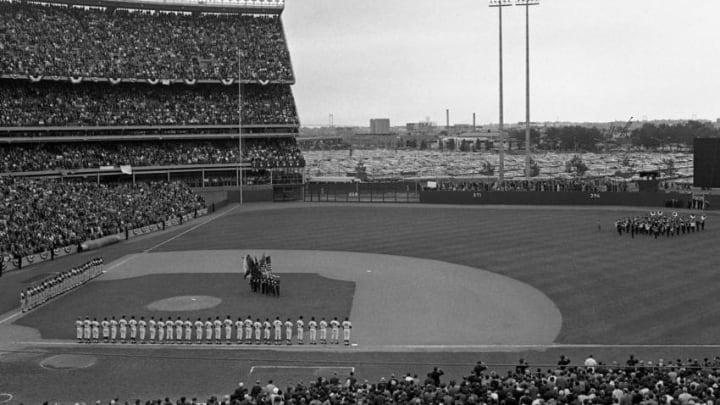Shea Stadium introduced herself to the world on April 17, 1964, with a New York Mets game against the Pittsburgh Pirates.
On April 17, 1964, the New York Mets played their very first game at Shea Stadium, a 4-3 loss to the Pittsburgh Pirates. The Mets, the newest addition to the New York baseball canon, were beginning their third season in the National League. For the past two years, the Mets had played their home games at the hallowed Polo Grounds, previously the home of the New York Giants baseball team from 1911 through 1957.
The Mets had not had much success in their first two seasons, going 40-120 and 51-111 in 1962 and 1963, respectively. But with the opening of their new ballpark in the spring of 1964, it seemed like a new beginning was in order for the still-young Mets franchise.
The stadium had been named after William Shea, a New York lawyer who had been integral to the process of bringing National League baseball back to New York. The Mets’ new ballpark had unofficially been referred to as “Flushing Meadows Municipal Stadium” before then-mayor Robert Wagner decreed that the stadium would be named after Shea. Though Shea grew to appreciate the honor, he often joked, “they’ll probably change the name 15 minutes after I’m dead.” Shea passed away in 1991, and luckily, the stadium was never renamed.
More from Rising Apple
- NY Mets News: Marcus Stroman sees “potential fit” with the Angels
- NY Mets were too “seek” and not enough “destroy” last winter
- NY Mets: 1 trade target to consider from each 100-loss team
- NY Mets: Top 12 free agents the team should look to sign this winter
- NY Mets: Jeff Wilpon’s legacy continues to plague the Amazins
Despite all of the fanfare leading up to that first game at Shea in 1964, the stadium still wasn’t quite ready by April 17.
As the early morning hours of Opening Day dawned, the grounds crews and construction workers were still dealing with sewage issues, drainage problems in the outfield, and painting the outfield fences.
But to the crowd of 50,312 people eager to see their Mets’ new stadium, it was a shiny a new toy as they could possibly ask for.
For that first game in Queens, the Pirates were coming off of an unremarkable 74-88 season in 1963 but boasted a talented roster. Their 1964 lineup included several future Hall of Famers, including Willie Stargell, Roberto Clemente, and Bill Mazeroski, along with future Met Donn Clendenon.
The Mets’ lineup had fewer household names, featuring the talents of slugger Frank Thomas in left field and future All-Star Ron Hunt at third base. Catcher Jesse Gonder, who hit in the cleanup spot, would have the interesting distinction in 1964 of leading the NL in passed balls while also finishing second in runners caught stealing, with the fourth-highest caught-stealing percentage of any NL catcher.
Right-hander Jack Fisher started the game that day for the Mets, with Tim Harkness, George Altman, Jim Hickman, Amado Samuel, and Larry Burright rounding out the rest of the lineup. Fisher matched up against Pirates righty Bob Friend, who ultimately earned the victory. Friend pitched a complete game while allowing three runs and seven hits, striking out five.
Fisher, on the losing side, went 6.2 innings while also giving up three earned runs, though he surrendered 11 hits and one home run. That homer, the first in Shea Stadium history, was hit by Stargell in the top of the second inning. He later added an RBI double in the fifth, driving in Clemente. Clendenon and Mazeroski drove in the other two runs for the victorious Pirates.
For the Mets, all of their offensive highlights that afternoon occurred in the span of four batters in the fourth inning. An RBI single from Gonder drove in Hunt for their first run, followed by a two-run double by Samuel two batters later.
There were several other “Shea Stadium firsts” from this game. The Pirates’ leadoff man Dick Schofield was the first batter ever to step up to the plate at Shea. Clemente, known for amassing exactly 3,000 hits in his illustrious big league career, was Shea’s first strikeout victim.
Hickman, with a walk in the bottom of the second, was the Mets’ first baserunner at their new stadium. And Ed Bauta, who came on in relief of Fisher in the 7th inning, was the first official losing pitcher at Shea for the Mets that day.
Though the Mets began their tenure at Shea Stadium with a loss, it would take only two more days for them to secure their first-ever victory in Queens, which came against the Pirates on Sunday, April 19. That game was a 6-0 win for New York and Al Jackson made headlines for pitching a complete-game shutout to become the first Mets winning pitcher in Shea’s history.
Aside from that first game, Shea played host to several other historical events in 1964. On Father’s Day 1964, Jim Bunning of the Philadelphia Phillies pitched a perfect game against the Mets, the only perfect game in Shea Stadium’s history. A few weeks later, Shea played host to the 1964 All-Star game in its inaugural season. 1964 was also the year that New York hosted the World’s Fair, the main site of which was right next door to Shea in Flushing Meadows-Corona Park.
Want your voice heard? Join the Rising Apple team!
But on April 17, 1964, the focus at Shea was all about the Mets. They would go on to play there for over 40 Amazin’ years and created countless memories there that would become imprinted into the fabric of Mets history.
